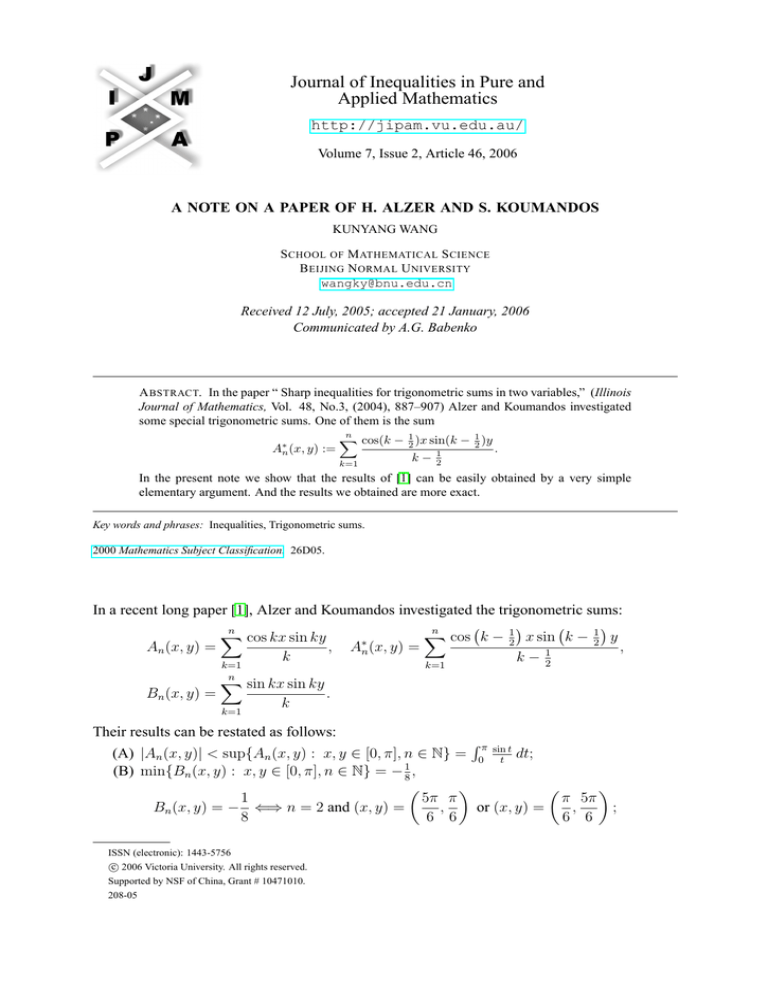
Journal of Inequalities in Pure and
Applied Mathematics
http://jipam.vu.edu.au/
Volume 7, Issue 2, Article 46, 2006
A NOTE ON A PAPER OF H. ALZER AND S. KOUMANDOS
KUNYANG WANG
S CHOOL OF M ATHEMATICAL S CIENCE
B EIJING N ORMAL U NIVERSITY
wangky@bnu.edu.cn
Received 12 July, 2005; accepted 21 January, 2006
Communicated by A.G. Babenko
A BSTRACT. In the paper “ Sharp inequalities for trigonometric sums in two variables,” (Illinois
Journal of Mathematics, Vol. 48, No.3, (2004), 887–907) Alzer and Koumandos investigated
some special trigonometric sums. One of them is the sum
n
X
cos(k − 12 )x sin(k − 12 )y
A∗n (x, y) :=
.
k − 12
k=1
In the present note we show that the results of [1] can be easily obtained by a very simple
elementary argument. And the results we obtained are more exact.
Key words and phrases: Inequalities, Trigonometric sums.
2000 Mathematics Subject Classification. 26D05.
In a recent long paper [1], Alzer and Koumandos investigated the trigonometric sums:
n
n
X
X
cos k − 12 x sin k − 12 y
cos kx sin ky
∗
An (x, y) =
, An (x, y) =
,
1
k
k
−
2
k=1
k=1
Bn (x, y) =
n
X
sin kx sin ky
k=1
k
.
Their results can be restated as follows:
Rπ
(A) |An (x, y)| < sup{An (x, y) : x, y ∈ [0, π], n ∈ N} = 0 sint t dt;
(B) min{Bn (x, y) : x, y ∈ [0, π], n ∈ N} = − 18 ,
1
5π π
π 5π
Bn (x, y) = − ⇐⇒ n = 2 and (x, y) =
,
or (x, y) =
,
;
8
6 6
6 6
ISSN (electronic): 1443-5756
c 2006 Victoria University. All rights reserved.
Supported by NSF of China, Grant # 10471010.
208-05
2
K UNYANG WANG
√
(C) − 32 ( 2 − 1) ≤ A∗n (x, y) ≤ 2,
2 √
= − ( 2 − 1) ⇐⇒ n = 2, (x, y) =
3
∗
An (x, y) = 2 ⇐⇒ n = 1, (x, y) = (0, π).
A∗n (x, y)
3π π
,
4 4
,
The purpose of the present note is to give more exact results by very much simpler proof.
For a continuous function f on D := [0, π] × [0, π] we define
min(f ) = min{f (x, y) : (x, y) ∈ D},
max(f ) = max{f (x, y) : (x, y) ∈ D}.
Our results are
(A0 )
Z
π
2(n+1)
2 cos(n + 1)t sin nt
dt,
sin t
0
π
min(An ) = − max(An ) = An π, π −
,
n+1
Z π
sin t
max(An ) < lim max(An ) =
dt.
n→∞
t
0
max(An ) = An
π
0,
n+1
=
(B0 ) For n ≥ 2
min(Bn ) = Bn
π
n
Z
=
π
n+1
(2n + 1)π
π
,
n(n + 1) n(n + 1)
sin(n + 1)t sin nt
dt < min(Bn+1 ),
sin t
lim min(Bn ) = 0.
n→∞
(C0 ) For all n
π
max(A∗n ) = A∗n 0,
n
Z π
2n sin 2nt
dt
=
sin t
0
>
max(A∗n+1 )
Z
→
0
π
sin t
dt, (n → ∞),
t
and for n ≥ 2
min(A∗n )
=
A∗n
3π π
,
2n 2n
π
n
Z
=
In particular, min(A∗2 ) = 23 (1 −
π
2n
√
sin 2nt
dt < min(A∗n+1 ) → 0 (n → ∞).
2 sin t
2).
The results (A), (B), (C) are easy consequences of (A0 ), (B0 ) and (C0 ) respectively.
J. Inequal. Pure and Appl. Math., 7(2) Art. 46, 2006
http://jipam.vu.edu.au/
A N OTE ON A PAPER OF H. A LZER AND S. KOUMANDOS
3
Proof of (A0 ). We have
An (x, y) =
n
X
sin k(x + y) − sin k(x − y)
2k
k=1
n
X
k(x+y)
1
cos t dt
2k
k(x−y)
k=1
n Z x+y
X
2
cos 2kt dt
=
=
Z
x−y
2
k=1
Z
x+y
2
n
X
2 cos 2kt sin t
=
x−y
2
Z
2 sin t
k=1
x+y
2
sin(2n + 1)t − sin t
dt =
2 sin t
=
x−y
2
Z
x+y
2
x−y
2
cos(n + 1)t sin nt
dt.
sin t
Then we get
max(An ) = An
π
0,
n+1
Z
π
2(n+1)
Z
−π
2(n+1)
π
2(n+1)
=
=
0
Z
cos(n + 1)t sin nt
dt
sin t
2 cos(n + 1)t sin nt
dt
sin t
π
2(n+1)
<
0
2 cos(n + 1)t sin(n + 1)t
dt =
t
Z π
sin t
dt;
lim max(An ) =
n→∞
t
0
Z
0
π
sin t
dt;
t
min(An ) = min{An (π − x, π − y) : (x, y) ∈ D}
π
= − max(An ) = An π, π −
.
n+1
Proof of (B0 ) and (C0 ). We have
Bn (x, y) =
=
n
X
cos k|x − y| − cos k(x + y)
k=1
n Z
X
k=1
Z
x+y
2
Z
|x−y|
2
x+y
2
=
=
J. Inequal. Pure and Appl. Math., 7(2) Art. 46, 2006
|x−y|
2
2k
x+y
2
|x−y|
2
sin 2kt dt
cos t − cos(2n + 1)t
dt
2 sin t
sin(n + 1)t sin nt
dt,
sin t
http://jipam.vu.edu.au/
4
K UNYANG WANG
n
A∗n (x, y)
1X
=
2 k=1
Z
x+y
x−y
1
cos k −
2
Z
x+y
2
t dt =
Then we get (B0 ) and (C0 ).
x−y
2
sin 2nt
dt.
2 sin t
R EFERENCES
[1] H. ALZER AND S. KOUMANDOS, Sharp inequalities for trigonometric sums in two variables,
Illinois J. Math., 48(3) (2004), 887–907.
J. Inequal. Pure and Appl. Math., 7(2) Art. 46, 2006
http://jipam.vu.edu.au/




